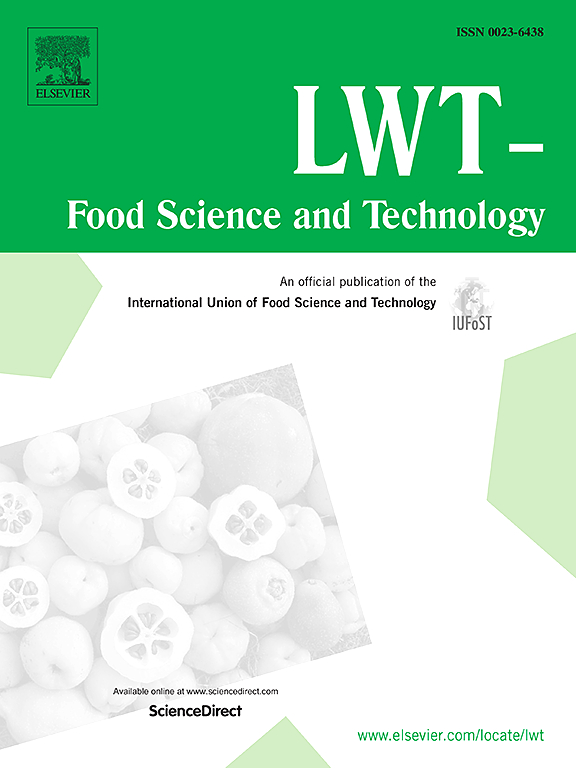Rheological properties and 3D printability of tomato-starch paste with different types of starch
IF 6.6
1区 农林科学
Q1 FOOD SCIENCE & TECHNOLOGY
引用次数: 0
Abstract
In this study, the effect of different types of starch (potato, wheat, corn, tapioca, and mung bean) on the quality of three-dimensional (3D) printed food products containing tomato-starch paste (TSP) was investigated. The printability of TSP was evaluated by examining its rheological and textural properties and the microstructure of 3D printed products. The results showed that the tomato starch paste containing wheat starch had the best printing accuracy and print quality compared to the other samples, which had an extruded line width of 0.93 mm and center heights and diameters of 18.56 mm and 20.15 mm. The macrorheological and microrheological analysis results showed that the apparent viscosity, loss modulus, storage modulus, and viscoelasticity of the TSP containing wheat starch were significantly higher than those of the other samples (P < 0.05). Low-field nuclear magnetic resonance (LF-NMR) results showed that T21 and T22 of TSP containing wheat starch significantly decreased, thereby improving the retention of printed shapes and deposition of 3D-printed TSP. The analysis of textural properties showed that TSP containing wheat starch had significantly higher strength in terms of hardness, elasticity, cohesion and chewiness, which were 9.58 N, 0.58, 0.31 and 2.13 N, respectively (P < 0.05). Thus, the pseudoplastic gel formed by TSP containing wheat starch exhibited a higher fluidity and structural density than the other samples, which improved the extrudability and shape stability of the printed product as well as the self-supporting properties of TSP.
含有不同类型淀粉的番茄淀粉糊的流变特性和 3D 打印性能
本研究调查了不同类型的淀粉(马铃薯、小麦、玉米、木薯和绿豆)对含有番茄淀粉糊(TSP)的三维(3D)打印食品质量的影响。通过检测番茄淀粉糊的流变和纹理特性以及三维打印产品的微观结构,评估了番茄淀粉糊的可打印性。结果表明,与其他样品相比,含有小麦淀粉的番茄淀粉糊的打印精度和打印质量最好,其挤出线宽为 0.93 毫米,中心高度和直径分别为 18.56 毫米和 20.15 毫米。宏观流变学和微观流变学分析结果表明,含小麦淀粉的 TSP 的表观粘度、损耗模量、储存模量和粘弹性明显高于其他样品(P <0.05)。低场核磁共振(LF-NMR)结果表明,含小麦淀粉的 TSP 的 T21 和 T22 明显降低,从而改善了打印形状的保持和三维打印 TSP 的沉积。质构特性分析表明,含小麦淀粉的 TSP 在硬度、弹性、内聚力和咀嚼性方面的强度明显较高,分别为 9.58 N、0.58、0.31 和 2.13 N(P <0.05)。由此可见,含有小麦淀粉的 TSP 所形成的假塑性凝胶比其他样品具有更高的流动性和结构密度,从而提高了印刷产品的挤出性和形状稳定性,以及 TSP 的自承性。
本文章由计算机程序翻译,如有差异,请以英文原文为准。
求助全文
约1分钟内获得全文
求助全文
来源期刊

LWT - Food Science and Technology
工程技术-食品科技
CiteScore
11.80
自引率
6.70%
发文量
1724
审稿时长
65 days
期刊介绍:
LWT - Food Science and Technology is an international journal that publishes innovative papers in the fields of food chemistry, biochemistry, microbiology, technology and nutrition. The work described should be innovative either in the approach or in the methods used. The significance of the results either for the science community or for the food industry must also be specified. Contributions written in English are welcomed in the form of review articles, short reviews, research papers, and research notes. Papers featuring animal trials and cell cultures are outside the scope of the journal and will not be considered for publication.
 求助内容:
求助内容: 应助结果提醒方式:
应助结果提醒方式:


